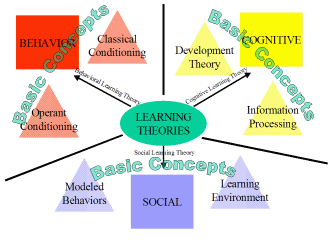
Cognitive Learning Theory - Web Quest

- Behavioral Theory
- Cognitive Theory
- Introduction
- Task
- Process
- Resources
- Evaluation
- Conclusion
- Social Learning Theory
Process
History of theorists and their contributions
- Noam Chomsky(1957)
- Bruner, Goodnow, and Austin(1956)
- Ulric Neisser(1967)
- Jerome Bruner
- David Ausubel
- Edward Tolman
- A prominent learning theorist during the heyday of behaviorism, yet his work had a distinctly cognitive flair. Tolman developed his mentalistic view of learning by using adaptive versions of behaviorist research. There are several central ideas of his theory:
- Behavior should be studied at a molar level.
- Learning can occur without reinforcement.
- Learning can occur without a change in behavior.
- Intervening variables must be considered.
- Behavior is purposive.
- Expectations affect behavior.
- Learning results in an organized body of information.
- The Gestalt psychologists of Germany
- Marx Wertheimer
- Wolfgang Kohler
- Kurt Koffka
- Gestalt psychologists emphasized the importance of organizationnal processes in perceptionn, learning, and problem solving and believed that individuals were prediposed to organize information in particular ways. There are several basic ideas of the Gestalt theory:
- Perception is often different from reality.
- The whole is more than the sum of its parts.
- The organism structures and organizes experience.
- The organism in predisposed to organize experience in particular ways.
- Learning follows the law of Pragnanz.
- Problem solving involves restructuring and insight
- Jean Piaget
- Piaget focused on mental events - logical reasoning processes and the structure of knowledge. I incorporates such diverse topics as language, logical reasoning, moral judgements, and conceptions of time, space, and number. the major components of Piaget's research in volve the following:
- People are active processors of information.
- Knowledge can be described in terms of structures that change with development.
- Cognitive development results from the interactionns that children have with their physical and social environments.
- The process through which people interact with the environment remain constant.
- People are intrinsically motivated to try to make sense of the world around them.
- Cognitive development occurs in distinct stages, with thought processes at each stage being qualitatively different from those at other stages.
- Lev Vygotsky
- Vygotsky died at a young age, but had several influential ideas in the field of cognitivism, such as:
- Complex mental processes begin as social activities; as children develop, they gradually internalize these processes and can use them independently of those around them.
- Thought and language initially develop independently of each other; the two become independent when children are about two years old.
- Children can accomplish more difficult tasks when they have the assistance of people more advanced and competent than themselves.
- Tasks within the zone of proximal development promote maximum cognitive growth.
Critical components /principles
Some of the critical components of cognitivisim are:
- A Dual-Store Model of Memory: there are many types of input and information being received by an individual at any given time.
- Sensory Register: information is filterd by the individual and short-term memory begins processing.
- Moving Information on to Working Memory: The Role of Attention
- Working Memory: the learner makes a decision to "work" with a particular piece of information, continuing to process the information.
- Long-Term Memory: at some point the information of importance to the learner has been organized and stored for later retrieval.
- Are Working Memory and Long-Term Memory really Different?
- Reception of patterns
- Executive control process
- Retrieval of prior learning
- Selective perception
- Semantic encoding
- Response organization
- Reinforcement
- Activating Retrieval for Reinforcement
- Strategies for Retrieval
There are various perspectives within cognitivism:
- Information Processing Theory (shown above)
- Constructivism
- Contextual Views
Basic Concepts
- Learning vs. Memory
- Learning is the acquisition of new information. Memory is related to the ability to recall information that has previously been learned.
- Storage
- The process of "putting" new information in memory.
- Encoding
- The process of storing information in memory and modifying it in some way.
- Retrieval
- The process by which people "find" information they have previously stored in memory so that they can use it again.
During this information processing, there are various things to consider:
Characteristics of the Sensory Register
Factors Influencing Attention
Characteristics of Working Memory
Control Processes in Working Memory
Characteristices of Long-Term Memory
Control Processes in Long-Term Memory
|
Information is constantly processed through the sensory registers. There are various factors that influence an individual's ability to process information. Information goes into our short-term / working memory for mere seconds. We organize the information and decide what to keep and what to discard. Stored information is in our long-term memory for later retrieval. |
Ideas how this theory informs Instructional Design
Gagne's Nine Events of Instruction
(Relation to Processes of Learning)- Gaining attention
- Informing the learner of the objective
- Stimulating recall of prerequisite knowledge
- Presenting the stimulus material
- Providing learning guidance
- Eliciting the performance
- Providing feedback about performance
- Assessing the performance
- Enhancing retention and transfer
These nine steps of instruction directly relate to the learning /information process.
